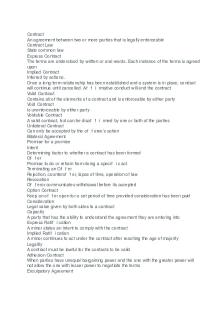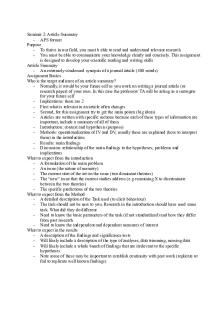Anthro 101 2 - Lecture notes 2 PDF

| Title | Anthro 101 2 - Lecture notes 2 |
|---|---|
| Author | julia kogut |
| Course | Introduction to Social and Cultural Anthropology |
| Institution | University of Delaware |
| Pages | 3 |
| File Size | 46.7 KB |
| File Type | |
| Total Downloads | 44 |
| Total Views | 144 |
Summary
lecture notes 2...
Description
(Time-space compression is a theory that considers the role of new communication and transportation technologies in speeding up our senses of time and place. Rapid communication and global travel are key components of globalization.) Which of the following best characterizes the current time period? - Anthropocene (The Anthropocene is defined as "the current historical era in which human activity is reshaping the planet in permanent ways" (page 21).) Which of the following do anthropologists believe to be true? - There are no longer any undiscovered, isolated groups of humans. (Technological changes such as enhanced transportation and communication ability and the advent of global positioning systems (GPS) suggest that no human group is truly isolated today. Moreover, most human groups are influenced by countless other cultures. Think about the number of global cultural influences present in contemporary music alone. Because of this, distinctions between "tribal" and "modern" tend to be difficult to discern in contemporary societies.) Which of the following is MOST likely to be studied by an anthropologist? - how minority residents of a small town react to discriminatory policies by working together
(Anthropologists are often, though not always, found studying marginalized groups of individuals in small-scale communities. They are far less likely to analyze broad trends or attitudes across entire nations or continents. They focus on humans, not dinosaurs. Anthropologists start with people and their local communities.) Which of the following would be considered participant observation? - living in a Brazilian shantytown community (favela) to learn how locals cope with poverty Participant observation is a technique within cultural anthropology that requires living and/or working with people consistently over a long period of time in order to better understand their beliefs and actions. "The ability or potential to bring about change through action or influence" (page 48) is known as - power (Contemporary anthropology often investigates relationships between culture and power. The "action or influence" mentioned in this definition can come from an individual or from a group.) Advances in transportation technology via seafaring allowed Europeans to travel farther and faster, thus seeing more of the diversity of the world's people. This resulted in the creation of the concept of different "races" of humans. This concept of race as signifying human difference is best described by which term? - mental map of reality
(Mental maps allow us to classify reality, then to assign meaning to what has been classified. Early racial classifications still influence our thinking on human differences today.) Americans tend to drive on the right side of the road. This is an example of a - cultural norm. ("Norms are ideas or rules about how people should behave in particular situations or toward certain other people-what is considered 'normal' and appropriate behavior" (page 37).) Bertha likes to eat dinner at 5 p.m. She travels to Italy and decides she doesn't like the country because restaurants tend to open for dinner at 7 p.m. or later. Bertha is practicing - ethnocentrism. (Ethnocentrism is "the belief that one's own culture or way of life is normal, natural, or even superior, and the tendency to use one's own culture to evaluate and judge the cultural ideas and practices of others" (page 42-43).) Bertram marries someone from outside his cultural group. Which anthropological term best applies to this situation? - exogamy (Exogamy is marriage outside of one's own group.) Contemporary debates about privacy in American society post-9/11 are fundamentally debates about which of the following? - cultural values ("Cultures promote and cultivate a core set of values-fundamental beliefs about what is important, what makes a good life, and what is true, right, and beautiful" (page 39).) Franz Boas believed that cultures develop in different ways because of the unique and complex sets of issues and situations that members of the cultural group face over time. This way of understanding cultural differences came to be known as - historical particularism. (Boas would inspire many other anthropologists to see culture in nonlineal ways and was among the first to recognize the importance of cultural history in determining current belief and behavior.) You arrive at a red, eight-sided sign when driving your car, and know that the sign is suggesting that you stop. - symbol Some, but not all, cultures participate in daylight savings time. - mental map of reality There are rules governing when to kiss someone. - norm Freedom of religion is a cornerstone of American society. - value The ability of individuals and/or groups "to contest cultural norms, values, mental maps of reality, symbols, institutions, and structures of power" (page 52) is known as - agency
(Agency is what allows humans to challenge power, thus allowing for the creation of cultural change. Such resistance is not always successful, of course, but is important for anthropologists to understand as we seek to comprehend processes of cultural change) The belief that cultural patterns are determined by our genetic makeup is best described using which term? Correct! - nature (The nature/nurture debate has been considered for decades throughout the social sciences. Increasingly, anthropologists find evidence that even early human behavior was influenced more by circumstance and environment than by genetic predisposition to certain activities. For instance, while men hunted and women gathered in many societies, this was certainly not the case in every human society. Similarly, the behaviors you exhibit today are more a product of your cultural surroundings than of instinct.) The belief that culture is held together by a series of important elements such as economy, education, religion, kinship, and politics that all serve to maintain societal equilibrium is known as - structural functionalism. (Structural functionalists purposefully ignored the influence of outside factors such as history and environment on societies, focusing instead on how societal "structures" such as economy, religion, etc. worked together. This type of focus, they argued, would yield better insight into the functioning of human societies.) The handshake as a form of greeting in the United States is an example of a - cultural symbol (The handshake itself is simply a behavior. Americans and others attach meaning to the handshake, however, thus making it a cultural symbol.) The human body contains roughly 100 trillion cells. Approximately what percentage of those cells are independent microorganisms? - 90% The suggestion that all cultures progress through a similar set of stages is no longer accepted in contemporary anthropology. This theory was known as - unilineal cultural evolution. (Unilineal cultural evolution theorized that all societies progress from savagery, through barbarism, to civilization. This theory is no longer accepted but represents an early effort to categorize human societies. Guess which categorization the inventors of this theory gave their own society? (They saw themselves as entirely civilized, of course!))...
Similar Free PDFs

Anthro 101 2 - Lecture notes 2
- 3 Pages

Anthro-1AB3-lecture-notes 2
- 41 Pages

Article 101 - Lecture notes 2
- 15 Pages

DRAMA 101 Lecture Notes 2
- 29 Pages

Economics 101 - Lecture 2
- 1 Pages

2 - Lecture notes 2
- 5 Pages

JLMC 101 - Exam 2 Notes
- 6 Pages

Lecture notes, lecture 2
- 3 Pages

Midterm 2 Review - Anthro Copy
- 2 Pages

2 Biodiversity - Lecture notes 2
- 33 Pages

Chapter 2 - Lecture notes 2
- 30 Pages

Blaw 2 - Lecture notes 2
- 4 Pages

Chapter 2 - Lecture notes 2
- 4 Pages

Seminar 2 - Lecture notes 2
- 2 Pages
Popular Institutions
- Tinajero National High School - Annex
- Politeknik Caltex Riau
- Yokohama City University
- SGT University
- University of Al-Qadisiyah
- Divine Word College of Vigan
- Techniek College Rotterdam
- Universidade de Santiago
- Universiti Teknologi MARA Cawangan Johor Kampus Pasir Gudang
- Poltekkes Kemenkes Yogyakarta
- Baguio City National High School
- Colegio san marcos
- preparatoria uno
- Centro de Bachillerato Tecnológico Industrial y de Servicios No. 107
- Dalian Maritime University
- Quang Trung Secondary School
- Colegio Tecnológico en Informática
- Corporación Regional de Educación Superior
- Grupo CEDVA
- Dar Al Uloom University
- Centro de Estudios Preuniversitarios de la Universidad Nacional de Ingeniería
- 上智大学
- Aakash International School, Nuna Majara
- San Felipe Neri Catholic School
- Kang Chiao International School - New Taipei City
- Misamis Occidental National High School
- Institución Educativa Escuela Normal Juan Ladrilleros
- Kolehiyo ng Pantukan
- Batanes State College
- Instituto Continental
- Sekolah Menengah Kejuruan Kesehatan Kaltara (Tarakan)
- Colegio de La Inmaculada Concepcion - Cebu

